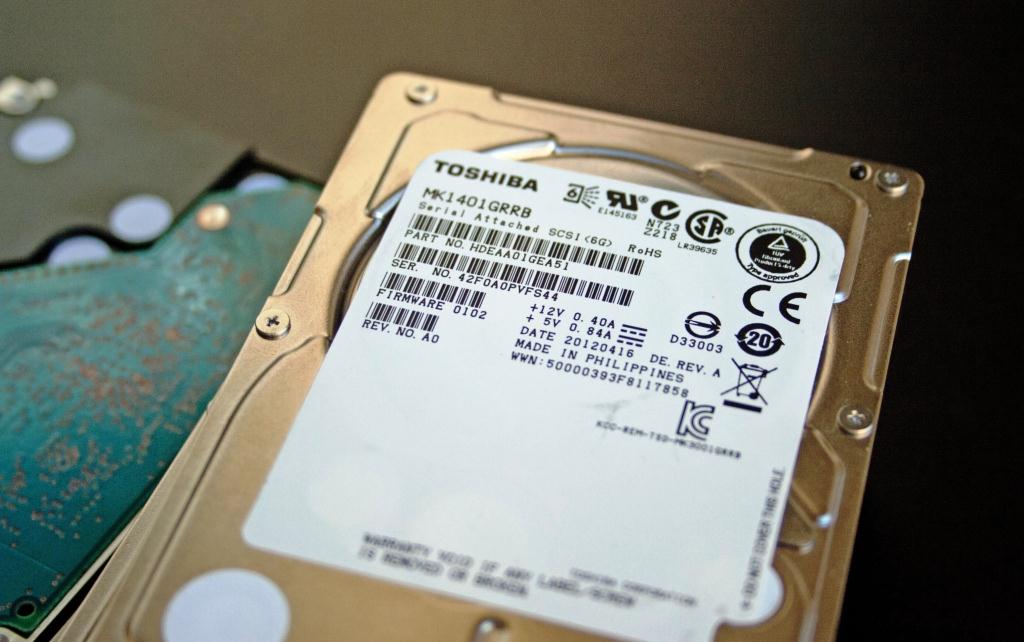To effectively test the LSI Nytro MegaRAID, we need hard drives. They don’t have to be scorchers, but it doesn’t hurt if they are. In this case, our friends at Toshiba jumped to the rescue and provided us with four Toshiba MK1401GRRB 15,000RPM SAS drives. They are just about the fastest drives available on the market today and and come in 147GB and 300GB capacities (a.k.a. the MK3001GRRB). In addition, if you want full disk encryption, both capacities have FDE-capable variants (denoted with an R instead of a B at the end of the model number). These Toshibas are balanced at all queue depths and transfer sizes and display outstanding characteristics.
The latency reduction you get from driving a disk at 15,000RPM isn’t anything to sneeze at either, but Toshiba has managed to reduce power consumption while maintaining a high level of performance. While most Nytro MegaRAID cards aren’t going to be deployed with only four array members under cache, we’re more interested in the total performance the Nytro MegaRAID delivers, and that’s bestowed by it’s cache flash modules. We’ll be able to really see the dynamic in system performance between cached and and non-cached performance.
The LSI Nytro MegaRAID NMR8120-4i that we have in house supports up to 128 SATA or SAS devices through the use of expanders. RAID levels of 0,1,5,6 are supported, as well as a few RAID combinations. The great part about using HDDs with a parity RAID on the Nytro is that rebuilds should take much less time when a drive fails and the array has to rebuild, thanks largely to the amount of NAND flash.
But first, we should get some baseline performance information from the MK1401s.
We’re using four Toshibas in RAID 0 on the Nytro MegaRAID, with a stripe size of 32K. That should allow a good balance between large sequentials and small randoms. With 128K and 1MB, we should get a gauge of the drive’s larger sequential performance. One drive tops out around 192MB/s, so the closer to 4x that number we get, the better.
The Toshiba SAS Drives don’t disappoint when attached to the Nytro. 128K reads and writes hit 748MB/s, and the same for 1MB/s reads. Only 1MB/s writes are slightly lower at 722MB/s. That’s impressive, but the MK1401s aren’t really for sequential transfers, they’re designed with small random performance in mind.

Each run is 60 seconds, with a 5 second ramp in between tests. We’re showing 4K IOPS at queue depths 1 through 64, with 100% read, 0% read (100% write) and a 65%/35% read write split.
And sure enough, the MK1401s are great here, with steady increases in performance with queue depths for the 100% and 65% reads, starting at 362 IOPS and ending up at 10x that by QD 64. 4K writes (shown in yellow in the above chart) put down over 2100 IOPS right at QD1, increasing to 2600 IOPS by QD 64. That’s excellent stuff, there. We don’t get the chance to spend a lot of time with hard drives here at The SSD Review, so it’s always fun when we do.
 The SSD Review The Worlds Dedicated SSD Education and Review Resource |
The SSD Review The Worlds Dedicated SSD Education and Review Resource | 

Just, WOW !
Another amazing review! Keep up the hard work. I’ve continued to be impressed by the rich content on this site.
Great looking piece from LSI and nice review Chris! What gets me though is the price of the unit. When you consider you can plug a SSD into a 9270 with CacheCade for a considrably cheaper end piece that 1 extra port gained for having onboard nand just doesn’t make fiscal sence.
What would be exciting would be to see the nitro’s flash set to 4 x X Gb units set in R0 nativly, (just like you can already using CacheCade and SSDs without the loss of more ports).
It’s great to see LSI developing their Pcie.3 offering and I look forward to where they take it in the future.